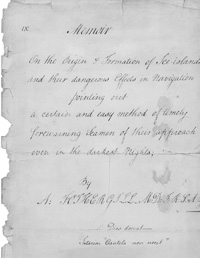
Cover page of Fothergill’s treatise on ice-islands, Reprinted from the Memoirs of the American Academy of Arts and Sciences, vol. 3, no. 1 (1809), 69.
Anthony Fothergill (1732–1813) was an Edinburgh-educated physician and natural historian. In 1806, he sent an essay to the Academy entitled “Memoir on the origin & formation of ice-islands, and their dangerous effects in navigation, pointing out a certain and easy method of timely forewarning seamen of their approach even in the darkest night.” Though some of his points had been anticipated independently by François Péron, a French naturalist and explorer, Fothergill made the following observations in his essay:
- That the origin, formation, and destination of ice islands, hitherto unknown, may now perhaps admit of a probable explanation, that may excite others to complete the discovery.
- That the arctic regions alone give birth to ice islands, and the liquefaction of the polar ices to the tides, as has been supposed seems highly improbable.
- That the ice islands observed in the more temperate seas, where the temperature decreases downwards, may originate where least expected, viz. at the bottom; especially where rocks and other conducting bodies overspread the surface.
- That the notion of central fire is groundless; and that objections, drawn from it, or volcanoes, are alike inadmissible.
- That ice in the open air evaporates even below the point of congelation, and that evaporation generates cold and accumulates ice in the curious cave of Grace Dieu most in summer.
- That the evils, occasionally produced by ice islands, are complained of, while their beneficial effects on the animal and vegetable creation have hitherto passed unnoticed.
- That winds, blowing over them, temper the intense heat of summer in the adjacent climates.
- That ice islands may be guarded against by vigilance, and by ships well constructed.
- That the thermometer may be rendered preeminently useful in pointing out the approach of rocks, shoals, and shores; but particularly of ice islands and the Gulph stream.
- That the barometer may also greatly contribute, and that these instruments should jointly constitute a part of the nautical apparatus, and daily observations be noted in the journals.
- Finally, that by due attention to the above rules those dangerous obstacles to navigation may be detected, which elude the magnetic needle and all other instruments; and thus might the art of navigation be improved, science promoted, and many disasters prevented.